01
Underground solutions
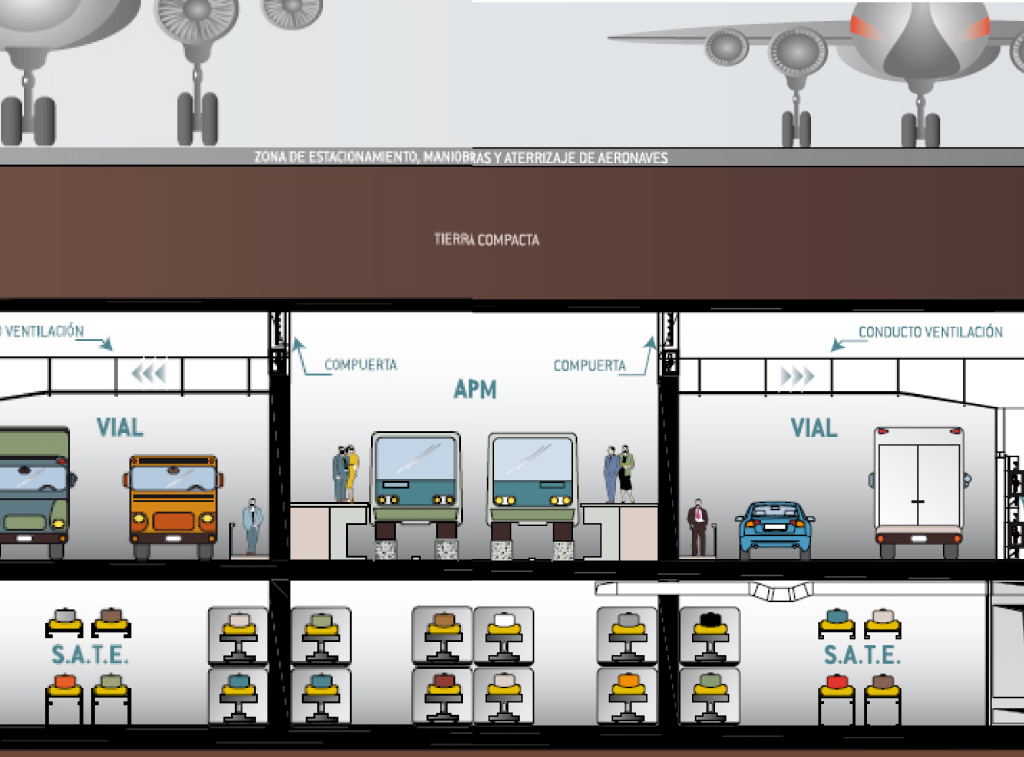
The rugged terrain of the Spanish territory has historically conditioned the design and execution of the road and railway network. Viaducts and, above all, tunnels, have been and continue to be the most effective (and in some cases the only possible) solution for overcoming natural obstacles and connecting territories or improving road or rail traffic.
Ineco, which in 1992 carried out its first tunnel works management project (the railway access to the SEAT factory in Martorell), has been involved for more than 20 years in the design, execution and maintenance, as well as in the modernisation, of all types of tunnels that have transformed transport in Spain both on the conventional rail network and high-speed rail network and on the road network, railway integration in urban areas, etc.
Even maritime and air transport modes require underground infrastructure: ports and airports need tunnels both to manage their land access and to operate safely.
For example, Spain's largest airport, Adolfo Suárez-Madrid-Barajas, has a eight tunnels network totalling some 7,983 m, which run through the subsoil of the airport site: those of the M-111 (which includes two branches to the control tower and the power station or CELA) and M-14 roads. Also, the two under runways, 14L-32R and 18L-36R,the airport services tunnel (TSA), with six openings or bays, through which passengers, baggage and vehicles circulate,the La Muñoza tunnel, the Dock Platform tunnel and the SATE T123 tunnel, which houses the Automated Baggage Handling System under terminal buildings 1, 2 and 3.
Ineco has participated in its development, as well as in other similar projects in different airports (Malaga, Barcelona...).
02
Pajares by-pass, challenge achieved
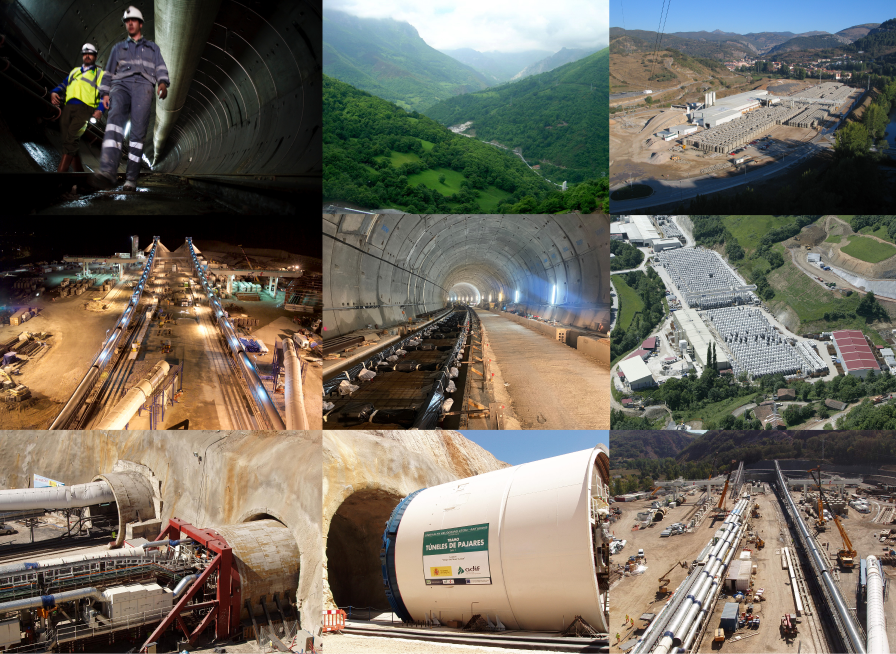
On November 29, 2023, the two 24 km long tunnels crossing the Cantabrian mountain range between León and Asturias would come into service. Single track, they have a circular cross-section of 8.5 m in diameter and are 50 m apart inside the massif, with connecting galleries every 400 m. They are the second longest in Spain after those of AV de Guadarrama (28 km, inaugurated in 2007 and in which Ineco also participated).
This is the key infrastructure of the Pajares bypass, which, according to the national railway administrator Adif, is "the most complex railway project developed in Spain" to date. In total, the bypass is 50 km long, 80% of it in tunnels, and its route represents a reduction of 37 km compared to the existing pass, which dates back to the 19th century.
Its commissioning marks the culmination of a long construction process fraught with technical challenges, with the aim of modernising the connection between Asturias and León, reducing the journey time between the two regions by one hour.
Among the numerous works carried out by Ineco, it is worth highlighting, among others, the informative study, the basic project, the complementary works and waterproofing projects, the preparation of fire resistance studies and the drafting of the construction projects for the emergency exits in the Pico de Siero and Vega del Ciego tunnels. Also the control of the tunnel construction works, track assembly, interlocking installations, train protection systems and telecommunications, as well as works and environmental management, control of supplies, traffic on site and support for commissioning.
Since 2005, a total of five TBMs have been used to bore up to 40 different geological formations. In addition to the maximum difficulty of the terrain, Adif also points out the fact of having to combine "the parameters of high-speed and freight traffic on the same line", something that in practice is extremely difficult.
To achieve this, and thus optimise the enormous effort made, the Iberian gauge (1,668 mm) East track has been equipped with a "third rail" or third rail system that allows high-speed trains to run on international or standard gauge (1,435 mm). To this end, among other actions, a gauge changer and a PAET (Train Overtaking and Parking Post) have been installed, as well as the ERTMS level 2 signalling and traffic control system.
- Status: IN SERVICE
- Location: Pola de Gordón (León) - Telledo (Asturias).
- Length: 24.000 m.
- Construction method: Five TBMs, one single shield and four double shield TBMs
- Type of tunnel: Single-track twin-tube, Iberina gauge (1,668mm), on both tracks and international gauge (1,435 mm) with third rail on East track
- Other similar project in the past: Design and construction management of the high-speed tunnels of Guadarrama, de 28,4 km long (2002-2007), and Abdalajís, de 7,3 km (2003- 2007) ,on the Córdoba-Málaga high-speed railway line.
The Pajares tunnels have became a reality, but other unique tunnel projects in which the company is currently participating are underway throughout Spain and abroad.
03
The International: Silvertown Urban Road Tunnel

The Jill TBM , named after Jill Viner, London's first female bus driver, completed boring the second Silvertown tunnel at the end of July 2023. Photo: TfL
An immense attack shaft with fourpeanut-shaped plant shafts has been used for the initial launch of Jill, the tunnel boring machine that in July 2023 completed the boring of the second of the two tubes that will form the new Silvertown tunnel in east London. The machine, some 12 m in diameter, crossed under the River Thames for the second time after turning 180º in the rotation chamber, thanks to an innovative system devised especially for the project.
When the new 1.4 km long tunnel comes into service from 2025, bus transport capacity in the area will increase six-fold. Currently, the only existing connection is the congested Blackwall tunnels, which have been in service for over 120 years, and have gauge limitations. The project also includes 600 m of access ramps (built in a cut-and-cover tunnel), maintenance buildings, connecting roads to the existing road network, a road bridge and a pedestrian footbridge.
Ineco has been involved since 2020 as Independent Certifier for the Riverlinx construction consortium and the project developer, Transport for London (TfL). A Permit to Use certificate, a document confirming that the project has been carried out in accordance with the requirements specified in the agreement between TfL and RiverLinx, will be issued upon completion of the works and for acceptance.
- Status: IN SERVICE
- Location: London (UK).
- Length: 1.400 m.
- Construction method: 600 m in cut-and-cover tunnel, rest by TBM
- Tunnel type: Road tunnel, two tubes (one in each direction) of two lanes each.
- Other similar projects: In Spain there is no similar figure to the British Independent Certifier, although Ineco has extensive experience in the supervision and management of works in all types of tunnels.
04
Urban: Atocha-Chamartín high-speed line
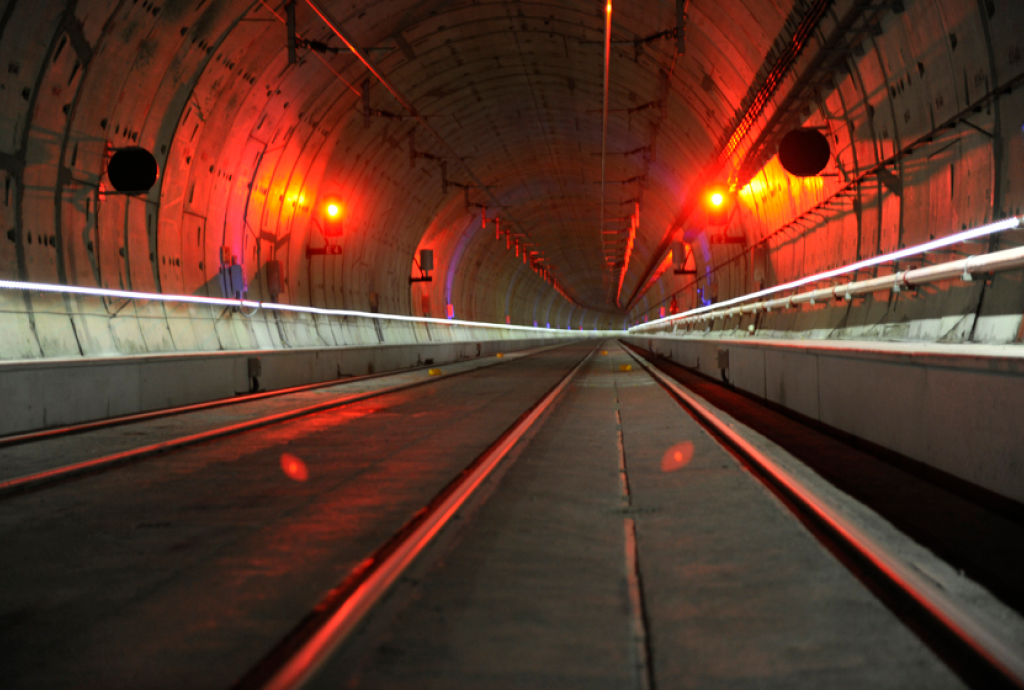
The Madrid Chamartín - Puerta de Atocha high-speed rail tunnel was put into service on July 1st 2022, next to the new high-speed southern access, between Atocha and Torrejón de Velasco. This access allows trains to run from north to south without changing gauge.
Ineco has actively collaborated with Adif in all phases of the project: design, execution of the platform, assembly of the track, catenary, and control, command and signalling installations, as well as commissioning.
This is the third major railway tunnel that crosses the city from north to south, together with the Recoletos and Sol tunnels, which mainly serve the Cercanías (commuter trains). With a length of 7.3 km, 6.8 km of which were excavated with a tunnel boring machine with a diameter of 11.4 m, it crosses under the urban ground of the centre of Madrid at a depth of up to 55 m.
Its ultimate aim is to connect all the high-speed lines in Spain, so far divided between the two major terminals of Chamartín (where the lines in the north and northwest of the country start and end) and Atocha (north-east, south and Levante) without transfers. Both stations are in the process of being gradually upgraded to make the latter a pass-through station and operate as one. Ineco is also working on this major project, which has already begun.

On the left, assembly of the cutting wheel of the tunnel boring machine in Chamartín (2011). On the right, one of the tunnel's emergency exits, the one in Espalter street (2017). Photos: Adif; Ineco/ Elvira Vila
- Status: IN SERVICE
- Location: Madrid city.
- Length: 7,300 m.
- Construction method: Tunnelling machine type EPB(Earth Pressure Balanced, EarthPressure Shield).
- Track: Double, slab, international gauge (1,435 mm)
- Other similar projects in the past: Design, environmental and site management (among other tasks) of the Sants-Sagrera high-speed tunnel in Barcelona (2013): it crosses the city centre by monuments such as the Sagrada Familia and Casa Milá. Thanks to previous ground reinforcement and protection treatments, together with an exhaustive campaign of auscultation and inspection of the surrounding buildings, the excavation was successfully completed with no surface damage.
05
Airports: Cercanías El Prat airport
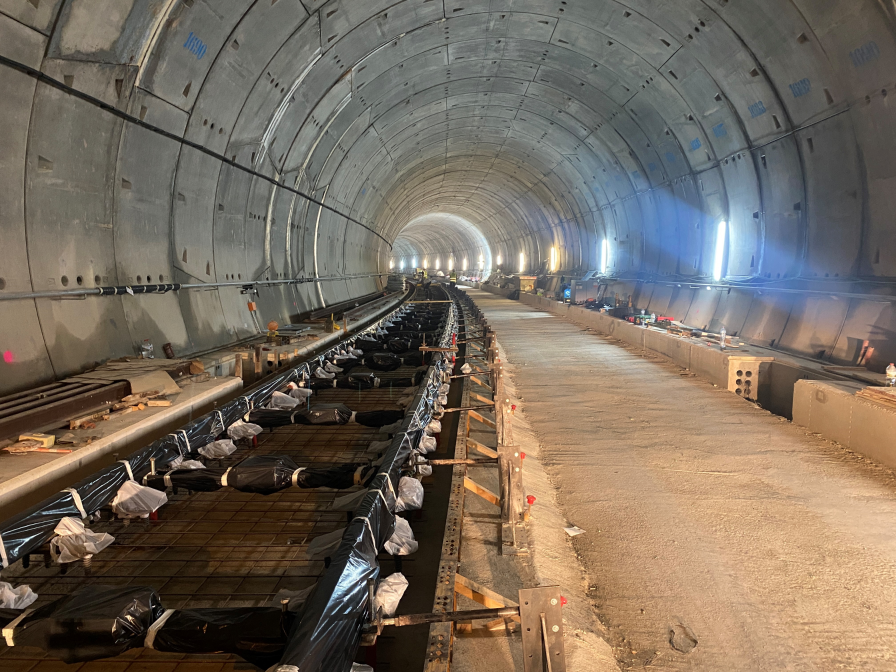
Ineco has drawn up the construction project and is managing the works to equip and put into service the large tunnel, more than three kilometres long and up to 28 metres deep, which crosses under the runways of the Barcelona El Prat-Josep Tarradellas airport. The aim of this major project is to extend the current suburban rail access to terminal T1. Upon the successful completion of the excavation in December 2018, Adif has undertaken the final phase of works, with the assembly of track and superstructure, which will culminate with the commissioning.
In 2009, the company also drew up the construction project and managed the works of the first phase, which in addition to the tunnel includes the new intermodal station in T2.
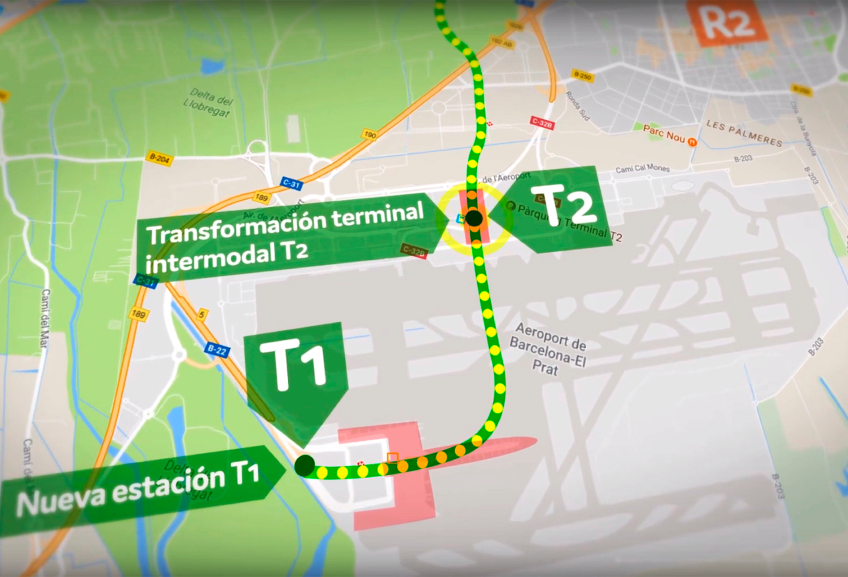
Both phases entail different technical challenges: during excavation, the most relevant were those related to the limited bearing capacity of the land, as the entire airport is located on the Llobregat river delta, which meant that the new T1 had to be built on a large concrete caisson.
To avoid the problem, ground improvement treatments(jet grouting, or injections of high-pressure reinforcement materials or micropiles) were established and ground stability and water tables were carefully monitored before and during the works, including the installation of more than 3,000 monitoring devices.
The tunnel, 3,048 m long (plus 400 m in a cut-and-cover tunnel), was built between almost 56,700 m² of walls and was lined with 32 cm thick concrete segments. A 10.6 m diameter EPB(Earth Pressure Balanced) tunnel boring machine was used to digging the tunnel.
In the current phase, the main singularities are related to the fact that the tunnel goes into the airside for more than one kilometre (the distance separating the two terminals), crossing under the runways where aircraft operate 24 hours a day, which conditions aspects such as the location of the smoke and emergency exits.
- Status: IN PROGRESS
- Location: Barcelona Airport.
- Length: 3.400 m.
- Construction method: Belgian. 400 m in cut-and-cover tunnel, rest with EPB TBM
- Track: Double, in slab, Iberian gauge (1,668 mm).
- Other previous similar projects: Barajas airport: feasibility studies for the construction of the tunnel network (2012) preliminary project for the access tunnel to the power station (CELA, 2005). Malaga airport: projects for the underground passage for handling vehicles in the new airfield and the variant of the suburban access tunnel and two stations (one of them underground) under the Guadalhorce river and the second runway (2009-2010).
06
The classic: New Oural Tunnel - conventional Ourense-Monforte-Lugo Line
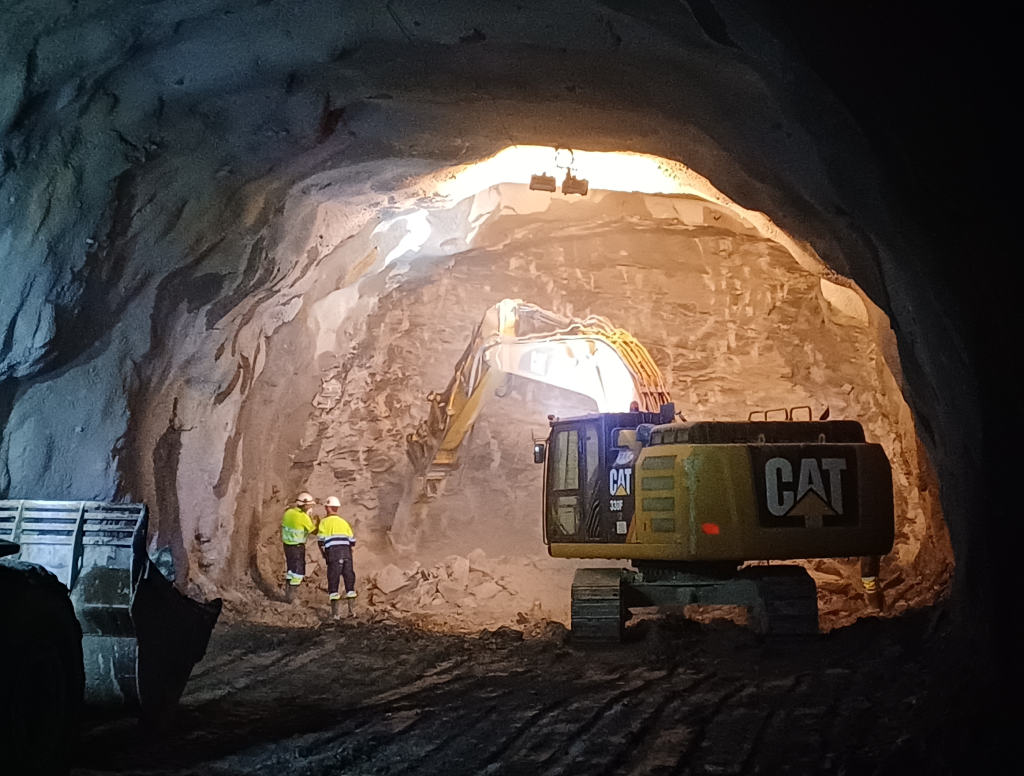
As part of its Plan to Combat Climate Change, Adif is electrifying conventional lines throughout Spain (or changing the system of some already electrified lines) while undertaking various actions to improve and modernise . This is the case of the conventional rail corridor Ourense-Monforte-Lugo, of 117 km.
Electrifying not only brings operational improvements, but also environmental improvements by eliminating diesel traction and with it, the consumption of fossil fuels. However, some of the older structures, especially tunnels, were not designed at the time to accommodate an overhead contact line and lack sufficient clearance.
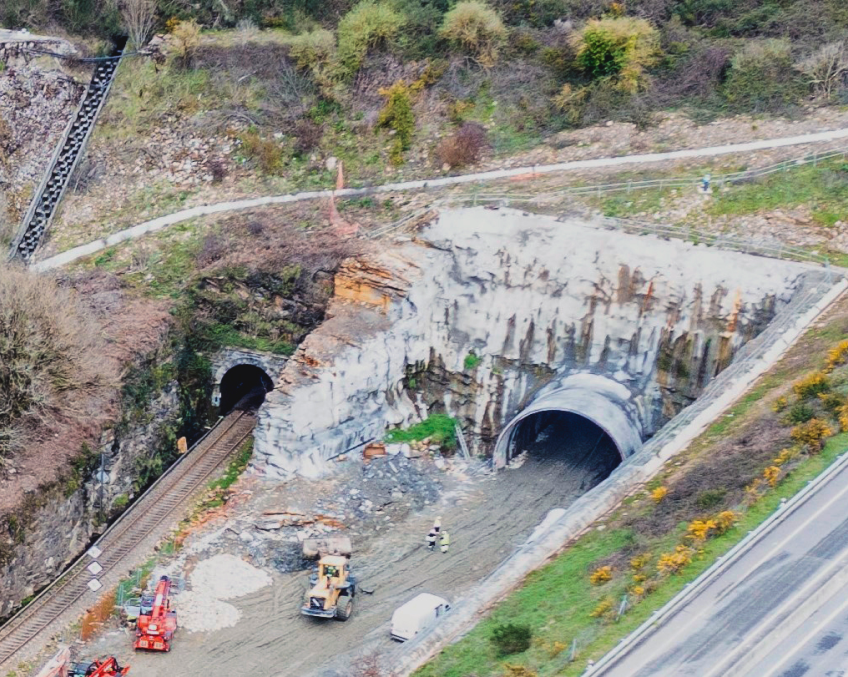
Where it is possible, it is adapted and where it is not feasible, a new infrastructure is built: this is the case of the new Oural tunnel in Lugo, which is 1,850 m long and runs parallel to the existing one. Ineco drew up the project in 2019 and is currently managing and controlling the works, which are already more than 50% complete. This is the most far-reaching action in the modernisation of the corridor.

The old and new tunnels, which run parallel to each other, will be linked by three transverse galleries. Image: Adif
The old tunnel, built 140 years ago and parallel to the new one, will be adapted to be reused as an evacuation gallery, for which the ballast and sleepers will be removed to allow vehicles to pass through. It will also receive a waterproofing treatment. In addition, there will be three transversal evacuation galleries (one for vehicles and two for pedestrians) located at a maximum distance of 500 m from each other and between the exits.
The new tunnel, with a section of 52m2 on a single track, is being excavated at the same time from both ends, using the classic or conventional system, that is to say, first by drilling with heavy machinery (in this case, a pick hammer) and then using explosives. Subsequently, the support is executed: there are different systems, according to the type of terrain and the particular method used. In the Oural tunnel, the most widespread method currently used is the New Austrian Tunneling Method(NATM), also known as the advance and breakthrough method, in which the excavation is reinforced with a layer of shotcrete immediately after drilling.
In Galicia, due to its geological characteristics, there are numerous tunnels excavated using conventional methods. Only on the section between the provinces of Zamora and Ourense, on the Madrid - Galicia High Speed Line, 29 of the 31 tunnels have been drilled with them, including the longest of the line, the two tunnels of El Corno, 8.5 km long. Ineco was present in all of them, both in the project management and in advising on the execution.
- Status: IN PROGRESS
- Location: Sarria ( Lugo).
- Length: 1.850 m.
- Construction method: Conventional - New Austrian method: two simultaneous excavation faces from both mouths
- Track: single track, in slab, Iberian gauge (1,668 mm).
- Other previous similar projects: Increasing the gauge of the Arroyo (225 m) and Callejo (130 m) tunnels to allow electrification of the Bilbao-Santander metric gauge ("narrow gauge") line (2021).
07
The sustainable: "solar" road tunnel in Alcantarilla, Murcia
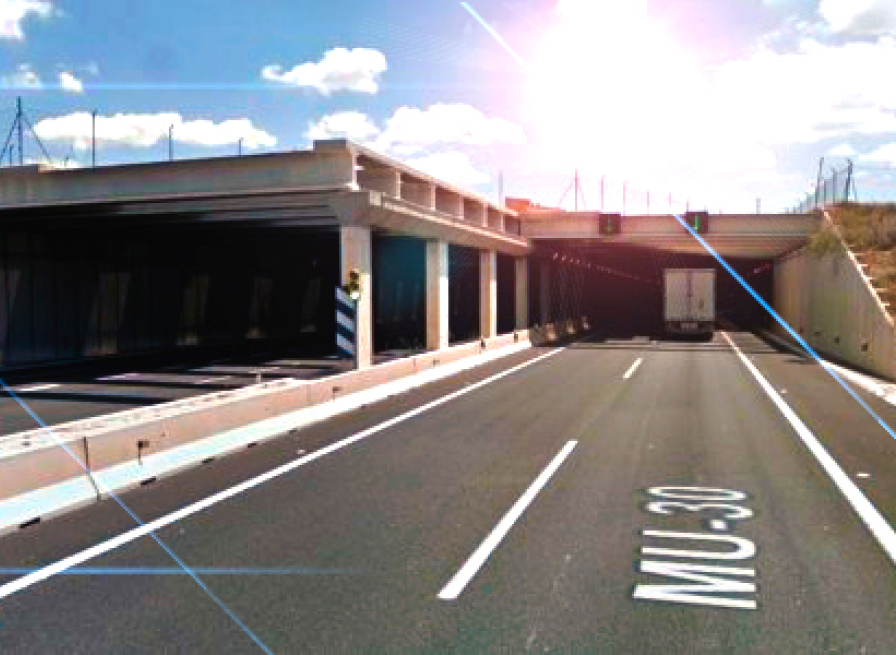
In 2022, Ineco carried out the project to improve the energy efficiency of the MU-30 motorway tunnel in Alcantarilla (Murcia) for Roads General Directorate of the Ministry of Transports, with the changeover of the existing vehicle lighting to LED technology, using an intelligent control system. The project includes the feasibility study for the construction of a photovoltaic solar park on the 1,150 m long tunnel, which was inaugurated in 2001. The aim is to promote sustainable mobility by installing some 5,000 solar panels on the roof slab, covering a surface area of 35,000m2.
The solar power plant will generate 4.822 MW h/year, and will not only serve to power the tunnel systems, but will also evacuate the surplus to the general electricity grid through an underground line connecting the generating plant to the transformer station, located about 4 km from the tunnel. The study includes an urban development action for the humanisation of the land adjacent to the solar plant, which will be developed once the technical proposal has been defined.
- Status: FEASIBILITY STUDY FINISHED
- Location: Motorway MU-30, Alcantarilla (Murcia) .
- Length: 1,150 m.
- Construction method: False tunnel
- Type of tunnel: Roadtunnel; undergrounding of motorway passing through the city centre; two lanes in each direction.
- Other similar projects: Construction project for a large photovoltaic solar plant for Adif (will generate 23 GW h/year, about 210,000m2) located next to the AV de Guadarrama tunnel , in Miraflores de la Sierra, Madrid. (2022).
+ work in progress
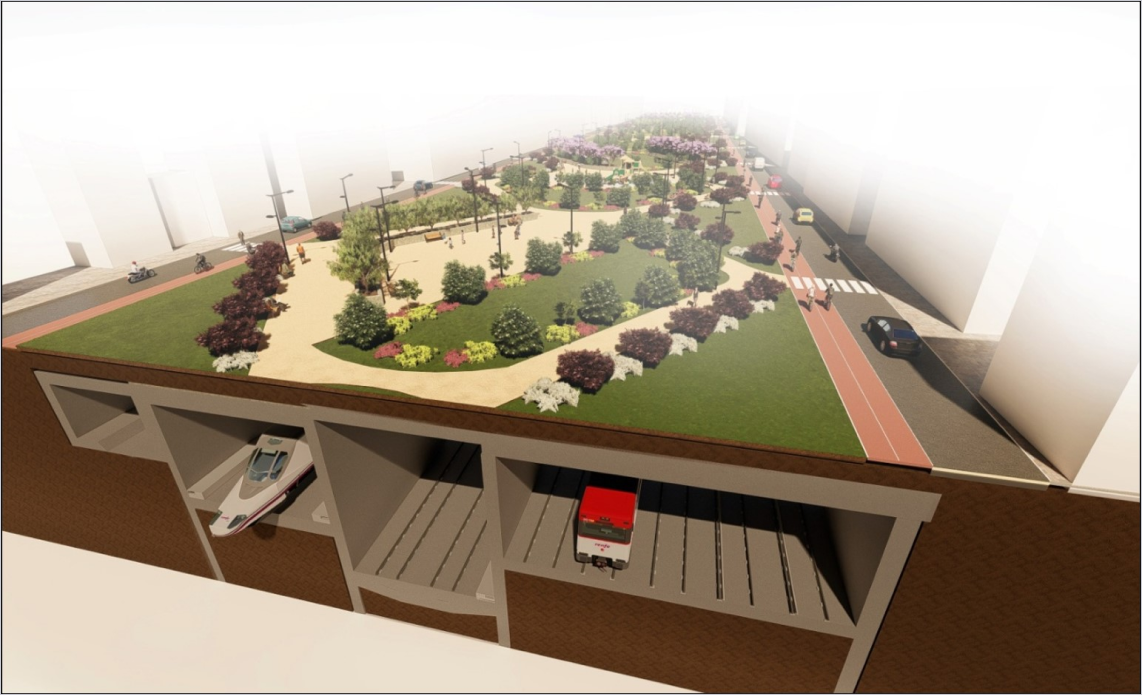
Recreation of the future underground railway access to Valencia. Photo: Ineco






